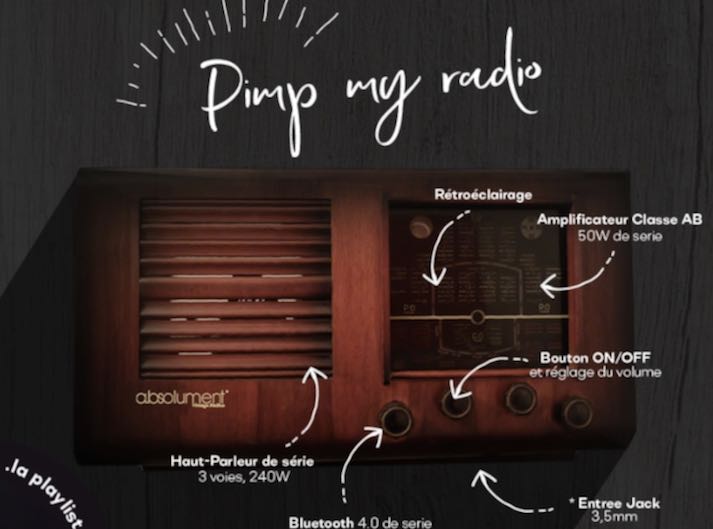 Many thanks to SWLing Post contributor, Kim Elliott, who shares this link to a French company called a.bsolument who specializes in converting vintage valve radios into hi-fidelity Bluetooth-connected audio devices.
Many thanks to SWLing Post contributor, Kim Elliott, who shares this link to a French company called a.bsolument who specializes in converting vintage valve radios into hi-fidelity Bluetooth-connected audio devices.
According to a.solument’s introduction video, they take vintage radios in disrepair, gut the insides and replace the components with modern hardware which includes Bluetooth 4.0 and aux-in capabilities:
https://vimeo.com/87657532
While I LOVE vintage radios, I have conflicting feelings about this process.
I take pride in keeping my vintage gear in proper working order (through the help of a mentor). Something that simply cannot be replicated with digital hardware is the sound and warm fidelity of AM audio emanating from a valve classic. At home, I have the option of feeding all of my vintage gear Bluetooth and wireless connectivity via an AM transmitter. This allows me to play any digital content while preserving the original audio fidelity (and warming my radio room with those glowing tubes!).
With that said, I’m very much aware that it’s becoming increasingly difficult for the average consumer to find a technician who can repair tube gear affordably. Indeed, some feel it’s impossible thus toss their family radio in the trash.
If a.bsolument is giving vintage beauties–that would otherwise be in a landfill–a new lease on life, then I’m all for it!
What do you think? Please comment!

40 years ago I acquired a 1939 Zenith floor model radio. Beautiful cabinet but someone had gutted the inside, for some reason. For years I had the circuit card out of a small transistorized bedside type AM radio in there fixed tune to one AM station and of course, no magic eye tube.
Finally, with the magic of Ebay, about 8 years ago I found a complete radio with horrible cabinet but intact chassis at a very reasonable price. I told the seller to scrap the cabinet and just send me the chassis and wavemagnet antenna. Of course it needed complete cleaning and recapping, resistor and frayed wiring upgrades, but now it is back playing beautiful sounding AM and Shortwave with the glowing magic eye tube.
I must apologize. I understood that replacing power supply filter capacitors and various other paper and molded capacitors would restore most vintage radios after a good cleaning. Sometimes replacement of tubes and other parts (transformers being the worst case) are required. Apparently, I am wrong. Bluetooth is the way to go, or conversion into flower pots. So it goes.
I don’t disagree that old radios should be restored if at all possible but, there is certainly a time an place to say, “I give up” but you still want to keep the original “box”. It’s pretty easy to DIY:
https://www.artofmanliness.com/2011/09/19/how-to-make-an-old-time-radio-into-an-mp3-player-speaker/
It isn’t too difficult to repair and maintain tube type radios. Anyone attempting to do this should be aware of lethal voltages present in these radios, hit the books and buy some test gear first. I want to do a full alignment on my Hammarlund SP-600 JX-21 before the end of the year. I spent the last month getting my AN/URM-25/D signal generator and ME-26 D/U VTVM in good working order. The VTVM needed a new filter capacitor ($1.38) and a replacement ballast tube ($15.00, ouch). I will be able to follow the SP-600 alignment procedure step-by-step thanks to military technical manuals available free online. I’ve got a nice pre-war AM/FM/SW Philco tabletop and a R-390A to do after that. Old radios are well worth restoration if at all possible.
What happens when blutooth dies and is no longer the preferred protocol, and in this day and age how long will that be?
This subject has come up here:
http://antiqueradios.com/forums/index.php
and they don’t think much of it either.
Browse the Discussions,Transistor and Vintage Forums…
geniuses at work restoring these old rigs.
Another similar maker (student startup) from Budapest
https://www.etsy.com/shop/YKONshop
A tad pricey, no? 🙂 Seriously, the seller could probably still make a decent profit at about one-fifth these prices or less.
This is a perversion. They simply destroy the old technique. Each such receiver is an architectural structure that provides a valuable opportunity to come into contact with ancient technologies. Gutted and filled with some kind of semiconductor junk, it loses all meaning.
If you can not restore things yourself, why ruin them? It is better to allow more capable and motivated people to do what is necessary. This is my opinion.
As long as I have a Bluetooth tactical flashlight I will be happy (I suppose).